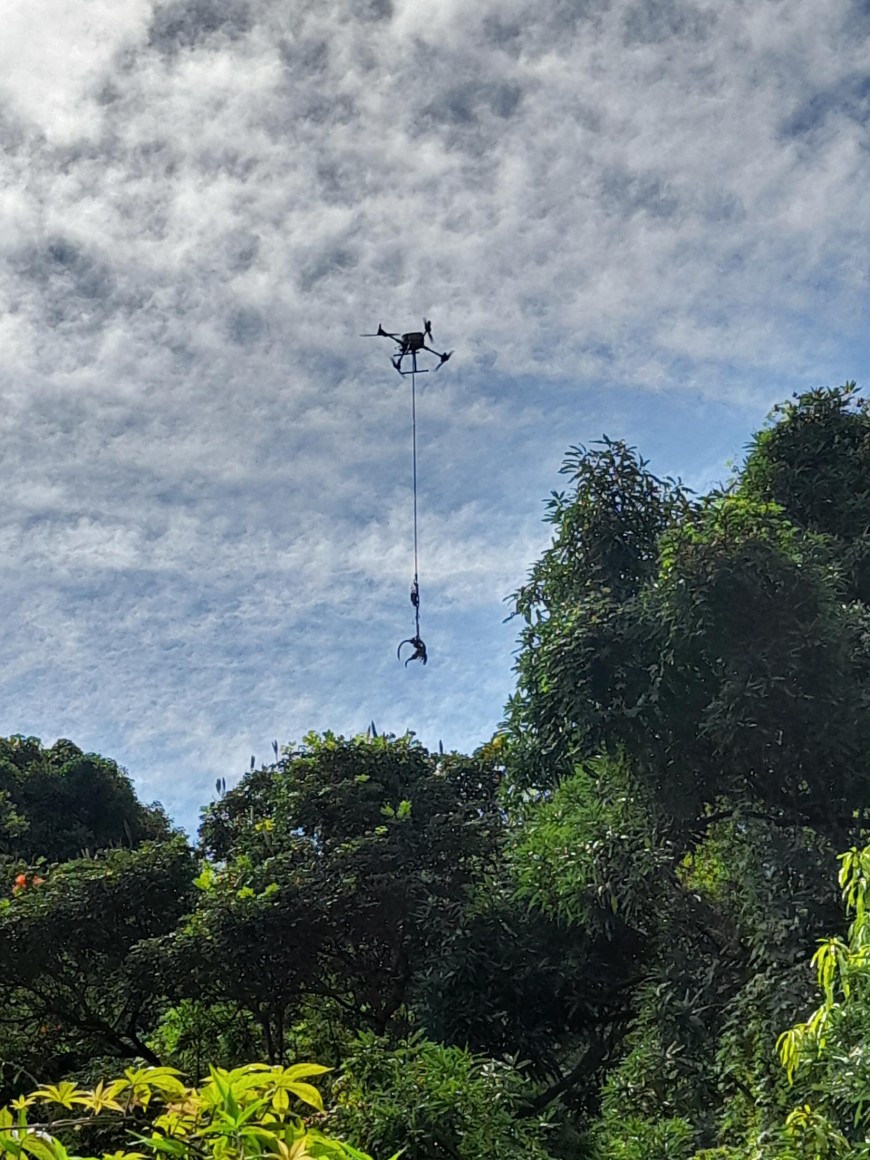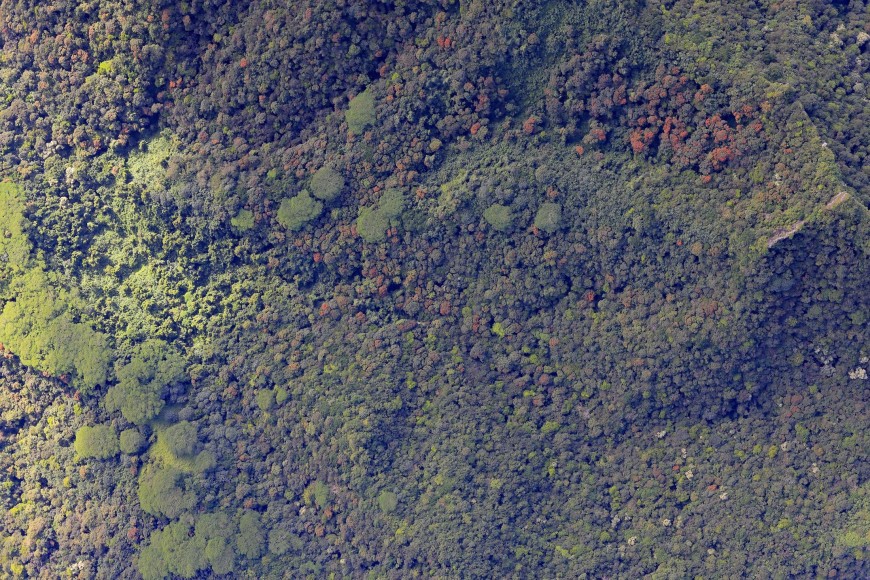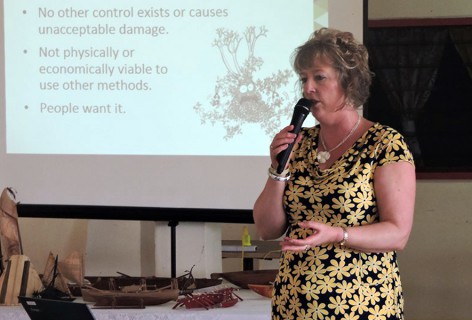Weed Biocontrol in the Cook Islands Shows the Way for Others
In their most recent visit to Rarotonga during July/August this year MWLR staff conducted surveys to assess progress and explore the use of remote-sensing technology to monitor weed populations and measure the long-term impacts of the biocontrol agents released. Baseline data on the extent of weed populations at the outset of weed biocontrol projects is often poor, at best, making it difficult to make the case for action and demonstrate the impact of biocontrol over time. The move to using this new technology has been needed for a while, because it will provide much more accurate data on weed distributions, on a more efficient scale for collection. “It is a big step up in data collection compared to transect surveys and ground-based photo points,” said Lynley Hayes, who is leading the Pacific programme of work.

Image: drone with claw flying in Rarotonga.
During the trip to Rarotonga earlier this year, the MWLR team led by Senior Field Technician, Paul Peterson, trialled the use of satellite imagery (50 cm resolution), imagery from an aeroplane (10 cm resolution), and drone close-up imagery (less than 4 cm resolution) to investigate which approach is likely to be the most cost-effective and practical for future use.
In addition to using RGB (red, green, blue; i.e. visible) photography, the team collected multi/hyperspectral imagery to capture reflected light that can’t be seen with the naked eye. They also used LiDAR, which is a method for determining ranges by targeting an object or a surface with a laser and measuring the time for the reflected light to return to the receiver. “It is likely that a combination of these methods will be used to produce weed distribution maps that we can use to monitor weed densities over time after biocontrol introductions”, explained Paul.
One of the weeds the team chose to focus on in these trials is the African tulip tree (Spathodea campanulata), which is considered one of the 100 worst alien invasive species in the world and is widespread throughout much of the Pacific region. African tulip trees are large trees that grow fast in disturbed areas, outcompeting native flora to take a dominant position in the canopy. They have large, bright red-orange flowers, which makes them easy to distinguish from the air when they are in flower from May to August, making them an ideal weed to monitor by aerial surveillance.

Image: aerial imagery showing African tulip tree infestation.
Two natural enemies of the African tulip tree have been released in Rarotonga. A gall-forming mite (Colomerus spathodeae) that stunts new growth was released in 2016 and quickly became well established and widespread. Galled leaves are easy to see, even when they are high up in tall trees. However, establishment of a leaf-mining flea beetle (Paradibolia coerulea) released in 2021 has been more difficult to determine. Beetle damage is quite subtle at low population levels, and difficult to spot up in the canopy, where it is suspected the beetles may be most active. This required Paul and his team to test another expensive tool at their disposal.
On their recent trip the team used a drone to take close-up images of the canopy. The drone was also equipped with a special claw attachment to sample foliage to look for signs of the beetles and their larvae. “This indicated that establishment of the flea beetle is looking likely. The RGB, multi/hyperspectral imagery, and LiDAR taken of the canopy have also been a success and will serve as the baseline data for long-term monitoring,” said Paul. It is hoped the beetle population will build up to damaging levels over the next few years, causing tree defoliation, which the team will be able to measure in the canopy composition across Rarotonga.
And now for some other exciting updates from the Cook Islands. The most impressive biocontrol agent released in the Cook Islands to date, the balloon vine rust fungus (Puccinia arechavaletae), still has its host, grand balloon vine (Cardiospermum grandiflorum), well under control. The balloon vine rust fungus was released in Rarotonga in 2017, and within 6 months a 90% decrease in balloon vine cover was achieved at some sites. Within 2 years the total percentage cover of the vine at the 20 release sites declined from over 75% to under 30%.
Image: balloon vine rust in Rarotonga.
As part of best practice MWLR regularly undertakes field surveys to check for unanticipated non-target damage from weed biocontrol agents. The team checked on the two closest relatives of balloon vine in Rarotonga, broad-leaved hopbush (Dodonaea viscosa) and Allophylus timorensis, and were able to confirm a clean bill of health with no sign of non-target attack, as predicted by host-range testing before release.
Progress is also being made against two other vines. A rust fungus (Puccinia spegazzini) is reducing the abundance of mile-a-minute (Mikania micrantha) at inland sites, although it appears to be much less effective in the coastal lowlands. Also, the red postman butterfly (Heliconius erato), which was released to control red passionfruit (Passiflora rubra), is now a common sight in Rarotonga.
This attractive butterfly is also the subject of an evolutionary study being led by Assistant Professor Gabriela Montejo-Kovacevich, who was formerly based at the University of Cambridge but has recently begun work at the Uppsala University in Sweden. This study is investigating potential changes in the butterflies due to different evolutionary pressures in Rarotonga compared to its native range; for example, the butterfly has fewer natural enemies in Rarotonga than in South America.
Lastly, two other biocontrol agents released in Rarotonga, a scale insect (Tectococcus ovatus) for strawberry guava (Psidium cattleyanum) and a rust fungus (Puccinia xanthii) for cocklebur (Xanthium pungens), were checked on. Populations of scale insects appear to be slowly building, and the rust is continuing to reduce the vigour of its host plant.
In summary, the recent, highly successful Cook Islands trip has provided more crucial markers for monitoring the impact of the biocontrol agents released, and has confirmed proof of concept for the new technology, which is encouraging for future use across the Pacific. A strong foundation has been built in the Cook Islands from which future benefits will be reaped. The lessons learnt can be used to help other Pacific Island nations as new biocontrol agents, currently in development, become available.
This project is part of the Managing Invasive Species for Climate Change Adaptation in the Pacific programme, which is funded by New Zealand’s Ministry of Foreign Affairs and Trade. This project would not have been possible without considerable international collaboration and assistance from: Cook Islands Ministry of Agriculture, Cook Islands National Environment Service, Droneworks Consultancy, Rhodes University, Te Ipukarea Society, University of the South Pacific, Federal University of Viçosa, United States Department of Agriculture, and United States Forest Service.

